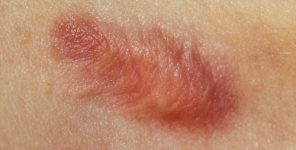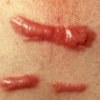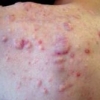Nei fibroblasti cheloidi, la simvastatina inibisce l'espressione del collagene di tipo I, di CTGF e α-SMA indotta dal fattore di crescita trasformante-β1
 La simvastatina, un inibitore della 3-idrossi-3- metilglutaril coenzima A reduttasi, viene spesso utilizzata per ridurre i livelli di colesterolo.
La simvastatina, un inibitore della 3-idrossi-3- metilglutaril coenzima A reduttasi, viene spesso utilizzata per ridurre i livelli di colesterolo.
Le prove accumulate mettono in luce gli effetti immunomodulatori e anti- infiammatori della simvastatina che sembrerebbero prevenire le malattie cardiovascolari.
Sono stati riportati anche gli effetti benefici delle statine sulla fibrosi di vari organi; tuttavia, non è stato ancora studiato l'effetto funzionale delle statine sulla fibrosi cutanea dei cheloidi.
L'obiettivo di questo studio è stato quello di determinare se la simvastatina potesse influenzare la fibrosi cutanea associata ai cheloidi.
Per fare ciò abbiamo esaminato l'effetto della simvastatina sulla produzione — indotta dal fattore di crescita trasformante (TGF)-β1 — di collagene di tipo I, del fattore di crescita del tessuto connettivo (CTGF o CCN2) e dell'α-actina del muscolo liscio (α-SMA).
I fibroblasti cheloidi sono stati coltivati ed esposti a diverse concentrazioni di simvastatina in presenza di TGF-β1; inoltre sono stati determinati gli effetti della simvastatina sulla produzione di collagene e CTGF indotta dal TGF-β1 nei fibroblasti cheloidi.
Con il western blotting, sono stati valutati i livelli di espressione del collagene di tipo I, di CTGF e di α-SMA, così come i livelli di fosforilazione di Smad2 e Smad3.
È stato valuto l'effetto della simvastatina sulla vitalità cellulare valutando la conversione colorimetrica del bromuro di 3-[4,5-dimetiltiazol-2- il]-2,5-difeniltetrazolio.
La simvastatina ha soppresso la produzione di collagene di tipo I, di CTGF e α-SMA indotta dal TGF-β1 in modo dipendente dalla concentrazione.
I livelli di fosforilazione di Smad2 e Smad3 indotti dal TGF-β1 sono stati totalmente abrogati dal pre-trattamento con simvastatina.
Inoltre, l'inibizione dell'espressione di collagene di tipo I, CTGF e di α-SMA da parte della simvastatina è stata invertita dal geranilgeranil pirofosfato, suggerendo che le risposte cellulari indotte dalla simvastatina sono dovute all'inibizione della GTPasi Rho.
Infatti, un test di attivazione RhoA ha dimostrato che la preincubazione con simvastatina blocca significativamente la produzione di RhoA indotta dal TGF-β1.
L'inibitore della Rho- chinasi (Y27632) ha indotto la produzione di collagene di tipo I, di CTGF e α-SMA.
Tuttavia, Y27632 non ha avuto alcun effetto significativo sulla fosforilazione di Smad2 e Smad3 indotta da TGF-β1.
In conclusione, questo studio suggerisce che la simvastatina sia un inibitore efficace della produzione di collagene di tipo I, CTGF e α-SMA indotta da TGF-β1 nei fibroblasti cheloidi.
Storia della pubblicazione:
Titolo: Simvastatin inhibits transforming growth factor-β1- induced expression of type I collagen, CTGF, and α-SMA in keloid fibroblasts
Rivista: Wound Repair and Regeneration. doi: 10.1111/wrr.12136
Autori: Je-Ho Mun, Young-Mi Kim, Byung-Soo Kim, Jae-Ho Kim, Moon-Bum Kim, Hyun-Chang Ko
Affiliazioni:Department of Dermatology, Pusan National University Yangsan Hospital, Yangsan, Republic of Korea Department of Physiology, School of Medicine, Pusan National University, Busan, Republic of Korea Department of Dermatology, Pusan National University Hospital, Busan, Republic of Korea Biomedical Research Institute, Pusan National University Hospital, Busan, Republic of Korea
Abstract:
Simvastatin, a 3-hydroxy-3-methylglutaryl coenzyme-A reductase inhibitor, is used to reduce cholesterol levels. Accumulating evidence has revealed the immunomodulatory and anti-inflammatory effects of simvastatin that prevent cardiovascular diseases. In addition, the beneficial effects of statins on fibrosis of various organs have been reported. However, the functional effect of statins on dermal fibrosis of keloids has not yet been explored. The objective of this study was to determine whether simvastatin could affect dermal fibrosis associated with keloids. We examined the effect of simvastatin on transforming growth factor (TGF)-β1-induced production of type I collagen, connective tissue growth factor (CTGF or CCN2), and α- smooth muscle actin (α-SMA). Keloid fibroblasts were cultured and exposed to different concentrations of simvastatin in the presence of TGF-β1, and the effects of simvastatin on TGF-β1-induced collagen and CTGF production in keloid fibroblasts were determined. The type I collagen, CTGF, and α-SMA expression levels and the Smad2 and Smad3 phosphorylation levels were assessed by Western blotting. The effect of simvastatin on cell viability was evaluated by assessing the colorimetric conversion of 3-[4,5- dimethylthiazol-2-yl]-2,5- diphenyltetrazolium bromide. Simvastatin suppressed TGF-β1- induced type I collagen, CTGF, and α-SMA production in a concentration-dependent manner. The TGF-β1-induced Smad2 and Smad3 phosphorylation levels were abrogated by simvastatin pretreatment. The inhibition of type I collagen, CTGF, and α-SMA expression by simvastatin was reversed by geranylgeranyl pyrophosphate, suggesting that the simvastatin-induced cellular responses were due to inhibition of small GTPase Rho involvement. A RhoA activation assay showed that preincubation with simvastatin significantly blocked TGF-β1- induced RhoA activation. The Rho-associated coiled kinase inhibitor Y27632 abrogated TGF-β1-induced production of type I collagen, CTGF, and α- SMA. However, Y27632 had no significant effect on TGF-β1- induced phosphorylation of Smad2 and Smad3. In conclusion, the present study suggests that simvastatin is an effective inhibitor of TGF- β1-induced type I collagen, CTGF, and α-SMA production in keloid fibroblasts.





